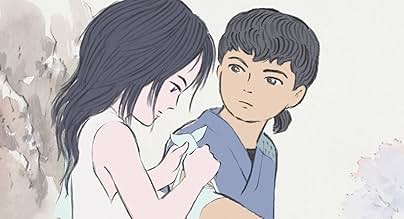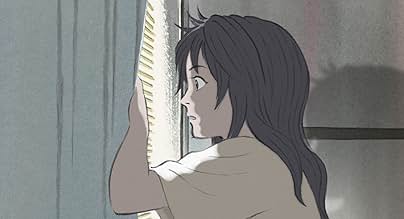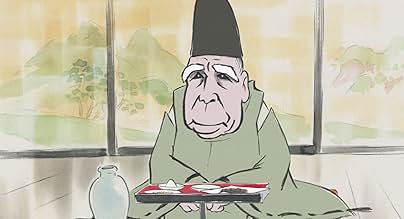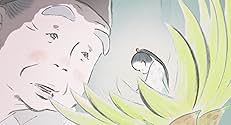Un cortador de bambú y su mujer descubren a una pequeña a la que acogen. La misteriosa princesa fascina a cuantos la conocen. Finalmente debe enfrentarse a su destino: el castigo por su crim... Leer todoUn cortador de bambú y su mujer descubren a una pequeña a la que acogen. La misteriosa princesa fascina a cuantos la conocen. Finalmente debe enfrentarse a su destino: el castigo por su crimen.Un cortador de bambú y su mujer descubren a una pequeña a la que acogen. La misteriosa princesa fascina a cuantos la conocen. Finalmente debe enfrentarse a su destino: el castigo por su crimen.
- Dirección
- Guión
- Reparto principal
- Nominado para 1 premio Óscar
- 13 premios y 38 nominaciones en total
- The Princess Kaguya
- (English version)
- (voz)
- The Bamboo Cutter
- (English version)
- (voz)
- The Bamboo Cutter's Wife
- (English version)
- (voz)
- …
- Prince Ishitsukuri
- (English version)
- (voz)
- Kaguya hime
- (voz)
- …
- Sutemaru
- (voz)
- Okina
- (voz)
- Ôna
- (voz)
- …
Reseñas destacadas
Based on a 10th century Japanese folktale, The Tale of Princess Kaguya is a bittersweet coming of age story. Our protagonist is Kaguya-hime who is discovered as a baby in a bamboo stalk by an old peasant man. He and his childless wife raise her as their own, providing the best they can as she rapidly ages. While her mother is fearful of change and just wants a comfortable life for her adopted daughter, her father envisions great things. He sees Kaguya as part of a divine plan and after fine clothes and gold come shooting out of bamboo stalks he concludes that the heavens want her to become a proper princess. He assumes this is the best way to make his daughter happy instead of asking her what she wants.
A sharply observed feminist critique of traditional Japanese culture as well as a cautionary tale of the burdens we place on our children, The Tale of Princess Kaguya has a wealth of complex themes and archetypes hidden beneath the surface of its fairly straight- forward story. This is one of the rare films that are both easily accessible to a young audience and one that film students can write thesis papers on.
The final word should be reserved for Studio Ghibli's animation. The style used invokes something between impressionist paintings and water-colours while employing a muted palette. Ghibli moves away from traditional anime and the results are breathtaking. The hand drawn frames could each stand alone as a portrait and yet the film feels fluid. At times the animation blurs into expressionism; the brush strokes matching the characters inner- turmoil.
Easily the best animated film of the year, it's a must see for fans of the genre. Luckily North America will get a theatrical release; the English-dubbed version will be out October 17 and will star Chloe Grace Moretz as Kaguya.
The film is beautiful. The animation is simple yet exquisite, reminiscent of old Japanese watercolours. Special kudos go to Joe Hisaishi for his superb soundtrack - the final scene and its music left me almost in tears.
The only problems lie in the sometimes slow development of the plot and a few loose ends. There are also tiny deviations from the original story, but I felt that it was as true to it as possible. All in all a beautifully drawn, beautifully crafted movie, solid voice acting (for a Japanese movie at least) and, again, the beautiful music. Excellent job, Ghibli.
Hats down to Mr. Takahata as well.
For the most part, the story you see in the film is the old tale. One day, a poor woodcutter slices into a stalk of bamboo and finds a beautiful thumb-size child. Since he and his wife are childless and have always wanted one, they are overjoyed with the discovery and raise the child. However, the same fortune that brought them the baby also rewarded them with gold when the woodcutter chopped additional bamboo. And, oddly, the child grows to normal size and becomes a lady in practically no time at all. Soon they are rich and able to give their girl the life of a princess and she's taught all manners and customs that a proper lady would need. However, it's obvious that young Princess Kaguya isn't happy in this life, as courtier after courtier come for her hand and she simply isn't interested. So, she gives them impossible tasks to complete before she'd agree to marry any of them. When they all fail, the Emperor himself comes to court her but she rebuffs him--mostly because she knows her time on Earth is drawing to a close. Where all this goes next, you'll find out if you watch the movie.
The animation for this movie is quite lovely--with a nice look that appears as if the film was made with colored pencils and watercolors. While it's more minimalistic than you'd usually find in a Ghibli film, it looks very appropriate to the Medieval Japanese period. In fact, the look of the film is the best thing about the movie. The story, as you probably noticed above, is odd--especially to non-Japanese audiences. The ending, is even odder, by the way. But the film still could have worked despite the unusual story. However, I found the pacing to be too slow and I noticed my attention waning from time to time. Not surprisingly, it's the longest film released by Ghibli to date. Had they trimmed about 15 to 20 minutes and removed the plot involving the poor boyfriend (which was not in the original story), I think the film would have worked better for me. Worth seeing for a very patient audience who is looking for something very different--otherwise a strange sort of picture that probably would offer little appeal to kids and folks wanting something light and Disney-like.
By the way, although I was not bowled over by this film, it has been nominated for the Academy Award for Best Animated Feature. My vote is for "The Box Trolls"...a film which managed to combine both artistry and an excellent original story.
¿Sabías que...?
- CuriosidadesIn several scenes in the movie, Kaguma-Hime, Lady Sagami and Ona can be seen wearing multi-layered kimonos called Junihitoe. Both the number of layers and the coloring of the layers worn would be dictated by the occasion, status, and season the wearer is in.
- PifiasWhile the baby princess crawls to the cutter she tosses a piece of bamboo to the edge of the floor mat. In the reverse shot as she crawls back, it is missing.
- Citas
The Princess Kaguya: [singing] Go round, come round, come round... Come round, oh distant time. Come round, call back my heart. Come round, call back my heart. Birds, bugs, beasts, grass, trees, flowers. Teach me how to feel. If I hear that you pine for me, I will return to you.
- ConexionesFeatured in Troldspejlet: Episodio #50.12 (2014)
Selecciones populares
- How long is The Tale of The Princess Kaguya?Con tecnología de Alexa
Detalles
Taquilla
- Presupuesto
- 5.000.000.000 JPY (estimación)
- Recaudación en Estados Unidos y Canadá
- 974.913 US$
- Fin de semana de estreno en EE. UU. y Canadá
- 54.915 US$
- 19 oct 2014
- Recaudación en todo el mundo
- 24.751.400 US$
- Duración2 horas 17 minutos
- Color
- Mezcla de sonido
- Relación de aspecto
- 1.85 : 1
Contribuir a esta página

































